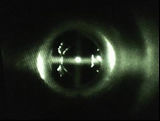
Ultracold atoms & molecules
Ultrafast lasers & ablation studies
Physics Research at Willamette University
Prof. Michaela Kleinert
Collins 314
Willamette University
Salem, OR 97301
Ultrafast lasers and ablation studies
Students interested in gaining experience on industrial pulsed laser systems have a unique opportunity to work with nano- and pico-second pulsed lasers, several of which have been donated to my lab by Electro-Scientific Industries (ESI). All in all, my lab has two pico-second lasers with pulse widths on the order of 10 ps, repetition rates between 200 kHz and several MHz, and average powers of 4 - 15 W, that are powerful enough to drill holes into metals or strongly alter the surface of metallic samples, as well as two nano-second lasers with pulse widths of 10 ns and repetition rates up to 40 Hz. One of those lasers can emit light at 355, 532, or 1064 nm, making it a very versatile instrument. An internal grant from Willamette University (Hewlett grant 2013) has provided funding to add a galvanometric scan lens system to one of the pico-second lasers, enabling us to very carefully and precisely move the laser pulses to any desired location on the work surface. This allows us to create and inscribe almost any desired pattern onto the metallic sample.
Hydrophobic surfaces:
Hydrophobic surfaces repel water similar to how a Lotus leaf does it in nature. We can create such surfaces by patterning metallic samples in a controlled way with a combination of large and small structures: The large structures are created when the laser beam is scanned over the metallic surface, and the small structures appear automatically for pico-second lasers (they're called LIPSS, or laser induced periodic surface structures). An example of such a patterned hydrophobic surface that demonstrates the large and small structures is shown in the figure below on the left. The right side of the figure shows how a water droplet maintains its shape when it is deposited onto such a patterned surface - an indication that the surface is indeed water-repellent.
We recently started a collaboration with Dr. David Altman (Willamette's biophysicist) on patterning titanium surfaces in a way that allows osteoblasts to adhere better to them. Better adhesion and cell health can improve the acceptance of titanium implants into the body, for example as knee or hip replacements.
Nanoparticles created via laser ablation in liquids:
Using our nano-second pulsed laser, we have created gold and silver nanoparticles in distilled water. Nanoparticles are small (on the order of a few ten to hundred nanometers in diameter), which gives them unique optical properties. Metal nanoparticles for example display characteristic colors due to their plasmon resonances, the wavelength at which they absorb incident light quite strongly. This phenomenon is caused by the collective motion of the electrons over the surface of the nanoparticle as they try to follow the direction of the electric field of the incident electromagnetic wave. If the electric field vector switches direction when the electrons reach the highest (or lowest) point of the nanoparticle, the collective oscillations of the electrons is in resonance with the incident electromagnetic wave. The figure below (left) shows gold nanoparticles (note the characteristic red color), and the right part of the figure shows the corresponding plasmon resonance of gold.
Nanoparticles find applications in a variety of fields. For example, they can be used to tag or destroy cancer cells when they are attached to proteins that preferentially bind to the cancer cells.




1
3
4
2